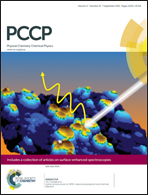The charge/discharge mechanism and electrochemical performance of CuV2O6 as a new anode material for Li-ion batteries†
Abstract
The charge/discharge mechanism of CuV2O6 as the anode for Li-ion batteries is studied for the first time, suggesting a phase transition in discharging, which initially involves the formation of LiV2O5 and Cu3V2O8, the subsequent transition from Cu3V2O8 to LixV2O5 and CuO, the insertion of lithium ions into LiV2O5, and later the reduction of CuO into Cu. The phase transition of Cu3V2O8 is accompanied by an amorphization process, which is maintained in the subsequent discharging and charging processes. The CuV2O6/natural graphite electrode with a sodium alginate binder is prepared, which shows superior electrochemical performance. At a specific current of 110 mA g−1, it delivers initial discharge and charge capacities of 725 and 453 mA h g−1, respectively, maintaining 537 and 533 mA h g−1 after 200 cycles.


 Please wait while we load your content...
Please wait while we load your content...